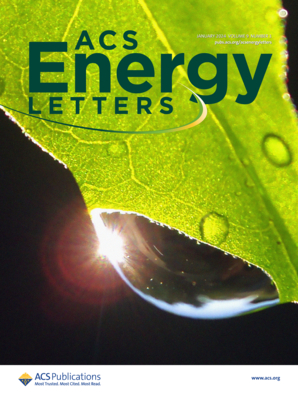通过 ni-p 过氧化物/硅串联太阳能电池中的多功能配体减轻埋入式界面能量损耗
IF 18.2
1区 材料科学
Q1 CHEMISTRY, PHYSICAL
引用次数: 0
摘要
由于氧化铌电子传输层(ETL)和包晶石之间的埋藏界面存在大量的重组损耗,因此制造高效的 ni-i-p 包晶石/硅串联太阳能电池仍然具有挑战性。在本文中,我们在该界面引入了自组装富勒烯(C60-SAM)夹层,并在其中加入了大量一价有机阳离子。我们发现这增强了 ETL 的表面电导率,缓解了界面重组,并减少了与上覆包晶石的能量失配。在器件层面,这导致了高效的电子萃取和器件滞后的抑制,漂移扩散模拟证实了这一点。这些改进结合在一起,在纹理硅上实现了无滞后的 ni-p 包晶石/硅串联太阳能电池,效率达到 27%(超过 1 平方厘米),开路电压达到 1.9 V。本文章由计算机程序翻译,如有差异,请以英文原文为准。

Mitigating Buried-Interface Energy Losses through Multifunctional Ligands in n–i–p Perovskite/Silicon Tandem Solar Cells
Fabricating efficient monolithic n–i–p perovskite/silicon tandem solar cells remains challenging, as evidenced by substantial recombination losses at the buried interface between the NbOx electron transport layer (ETL) and perovskite. Herein, we introduce a self-assembled fullerene (C60-SAM) interlayer at this interface, with a large monovalent organic cation incorporated. We find this enhances the surface conductivity of the ETL, mitigates interface recombination, and reduces the energetic mismatch with the overlying perovskite. At the device level, this results in efficient electron extraction and suppressed device hysteresis, substantiated by drift-diffusion simulations. The combination of these improvements led to hysteresis-free n–i–p perovskite/silicon tandem solar cells on textured silicon with an efficiency of 27% (over 1 cm2) and an open-circuit voltage reaching 1.9 V.
求助全文
通过发布文献求助,成功后即可免费获取论文全文。
去求助
来源期刊

ACS Energy Letters
Energy-Renewable Energy, Sustainability and the Environment
CiteScore
31.20
自引率
5.00%
发文量
469
审稿时长
1 months
期刊介绍:
ACS Energy Letters is a monthly journal that publishes papers reporting new scientific advances in energy research. The journal focuses on topics that are of interest to scientists working in the fundamental and applied sciences. Rapid publication is a central criterion for acceptance, and the journal is known for its quick publication times, with an average of 4-6 weeks from submission to web publication in As Soon As Publishable format.
ACS Energy Letters is ranked as the number one journal in the Web of Science Electrochemistry category. It also ranks within the top 10 journals for Physical Chemistry, Energy & Fuels, and Nanoscience & Nanotechnology.
The journal offers several types of articles, including Letters, Energy Express, Perspectives, Reviews, Editorials, Viewpoints and Energy Focus. Additionally, authors have the option to submit videos that summarize or support the information presented in a Perspective or Review article, which can be highlighted on the journal's website. ACS Energy Letters is abstracted and indexed in Chemical Abstracts Service/SciFinder, EBSCO-summon, PubMed, Web of Science, Scopus and Portico.
 求助内容:
求助内容: 应助结果提醒方式:
应助结果提醒方式:


